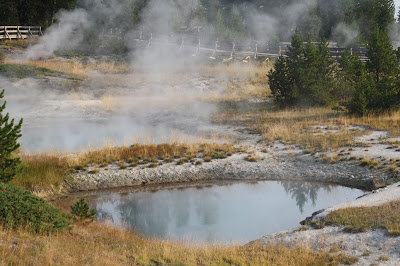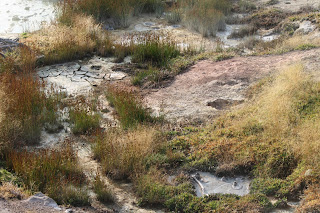 |
| Wow! What Color!
|
Our last morning at Yellowstone brought us to the South entrance. This would be the way we would leave the Park. But before heading south, we veered slightly to the East to the West Thumb Geyser Basin. It is adjacent to the Yellowstone Lake. There are three tiny geysers/springs that are IN the lake...The Big Cone, The Fishing Cone and The Lakeshore Geyser. And Lakeside Spring. There are three other geysers, some fumaroles, several springs and pools and the Thumb Paint Pots. A potion of the boardwalk trail is 1/4 mile. The longer loop is 1/2 mile. Yellowstone Lake is the largest lake at a high elevation (over 7,700 feet). The Lake is approximately 14 x 20 miles with a shoreline of 141 miles. The maximum depth is 410 feet. Despite the release of thermal hot water, the lake's average summer temperature is 45 degrees (F). Although we did not see them, it is a favorite place for trumpeter swans and moose.
Information provided by pamphlets published by Yellowstone Association and "Oh, Ranger Yellowstone National Park."
All photos by "Molly" Marston
Information provided by pamphlets published by Yellowstone Association and "Oh, Ranger Yellowstone National Park."
All photos by "Molly" Marston
 |
| Canada Geese checking out breakfast |
 |
| Yum! A hot breakfast |
 |
| Near Hillside Geyser |
  |
| Lakeshore Geyser |
 |
| Big Cone (in the lake) |
| Fishing Cone
Often submerged in lake. Water level drops in late summer
allowing cone to become visible. Its name comes from the
mountain man legend of catching a trout in the lake, swinging
the pole around, dip it into the boiling water in the pool. The
fish would be cooked without taking it off the line. Fishing is
no longer allowed in/around this cone. Many injuries from
straddling the boiling water and damage to the cone by feet
led to this change.
|
 |
| Active boiling mud pot |
Mudpots appear to be a field of miniature volcanoes
approximately 3-4 feet high, steam curling from their
chimneys. The mud swirls and bubbles and can be
thrown up to 25 feet. Often looks like a potter's shed.
Mudspots differ from other thermal features. The water
is much more acidic, dissolving surrounding rock to clay mud.
Precipitation and ground water levels can vary the consistency.


















































No comments:
Post a Comment